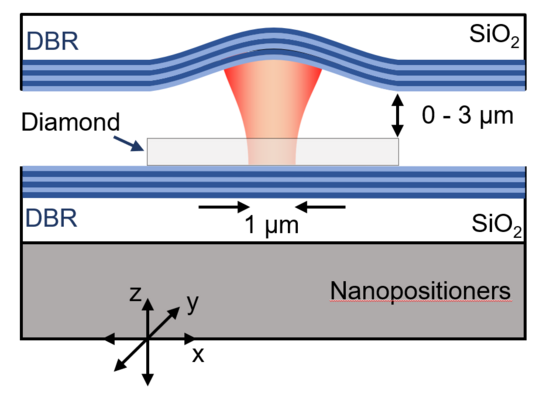Spin-Photon Interface

Despite major recent breakthroughs, NV center-based quantum applications are limited by the inability to produce high-fidelity entanglement between the NV electronic spin and a coherent zero-phonon line photon at high rates. Embedding a NV center in a resonant optical cavity and operating in the weak regime of cavity QED would allow to both speed-up the spin-photon entanglement rate and increase the entanglement fidelity.
Our approach relies on a fully tunable, open Fabry-Perot micro-cavity. The bottom mirror is a plane mirror; the top mirror is curved to confine the light. The radius of curvature of the top mirror is typically 10 microns, and the distance between the two mirrors is at most a few microns, keeping the mode volume to a minimum while maintaining high Q-factors thanks to high-reflectivity dielectric mirrors and minimal scattering losses. Diamond micro-platelets hosting individual NV centers can then be bonded to the bottom mirror thanks to Van der Waals forces [1]. This approach allows to fully optimize the cavity resonant frequency, the NV center coupling rate and the mode matching to a propagating optical fiber.
The interaction of the cavity mode with the NV centers was already shown to significantly enhance their radiative recombination rate [1]. However, one of the remaining limitations is set by the broadening of the NV centers zero-phonon line due to fabrication processes. In order to tackle this challenge, we develop advanced fabrication methods yielding NV centers with enhanced optical properties, for example laser writing [2].
In addition to single NV-center interaction, our system also allows to explore other enhanced light-matter interactions such as cavity-enhanced Raman scattering, opening paths toward miniature diamond-based lasers and other photonic devices [3],[4].
Explore our other projects: Magnetometry Sensing Technology
[1] Deterministic enhancement of coherent photon generation from a nitrogen-vacancy center in ultrapure diamond
D. Riedel, I. Söllner, B. J. Shields, S. Starosielec, P. Appel, E. Neu, P. Maletinsky, R. J. Warburton
Phys. Rev. X 7, 031040 (2017)
[2] Low charge-noise nitrogen-vacancy centers in diamond created using laser writing with a solid-immersion lens
V. Yurgens, J. A. Zuber, S. Flågan, M. De Luca, B. J. Shields, I. Zardo, P. Maletinsky, R. J. Warburton, T. Jakubczyk
ACS Photonics, 8, 6, 1726–1734 (2021)
[3] Cavity-Enhanced Raman Scattering for In Situ Alignment and Characterization of Solid-State Microcavities
D. Riedel, S. Flågan, P. Maletinsky, R. J. Warburton
Phys. Rev. Applied 13, 014036 (2020)
[4] High quality-factor diamond-confined open microcavity
S. Flågan, D. Riedel, A. Javadi, T. Jakubczyk, P. Maletinsky and R. J. Warburton
arXiv:2105.08736 (2021)
Quick Links
